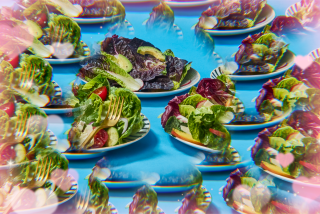Luck O’ the Garnish : The plant’s leaves, with a unique flavor somewhere between cabbage and spinach, are replacing parsley at salad bars.
- Share via
The dark green, frilly leaves of the kale plant are a familiar sight at restaurant salad bars, but more likely than not, they aren’t for eating.
Large and hearty, lasting a good while once harvested, kale leaves are fast becoming the garnish of choice in the food service industry. They are replacing that ubiquitous piece parsley, the reigning king of entree accents at most eateries.
“Most of the kale grown in Ventura County is sold for decoration,” said Jon Nishimori, a salesman for San Miguel Produce in Camarillo.
The plant falls into that general vegetable category known as “greens,” which includes mustard, chard, beet and turnip greens, collards and spinach. Some are cabbage-like in texture, others tender. None is quite like kale.
Its curly leaves offer a robust flavor and are high in calcium, iron and vitamins A and C. And unlike other greens, kale holds its texture when properly cooked.
“All grocery stores carry kale and sell a fair amount of it,” Nishimori said, adding that kale can be grown all over Ventura County throughout the year.
“Seed companies are constantly updating different varieties in test trials,” he said. “We’ll grow the variety that does best for our climate. Some might be more resistant to mildew. Some might have a longer stem, or maybe a wider leaf and not as curly. It’s all the same plant.”
Kale is a perennial plant grown in elevated beds, single-file. Unlike other greens, which are grown for a single harvest, the plant is left in the ground to produce for six months or more, Nishimori said. Harvest time arrives about every 45 days.
Loose leaves are sliced from a sturdy trunk, which stands 2 to 3 feet high, he said. Most of the plants’ bushy leaves are picked, except a few at the top. With an exposed trunk and few remaining leaves, the result is a tiny tree-like appearance.
“We’ll leave the plant in the ground up to a year,” Nishimori said. (Collard greens, a similar plant, is harvested in the same fashion.)
The food industry’s keenness for kale seems to be one of economics.
“It’s more reasonably priced and much more durable than parsley, Nishimori said. “It stays fresh and useable a lot longer.”
Although the food industry is serving up kale to garnish their plates, that doesn’t mean it isn’t being consumed.
“People use it for all kinds of things,” said Therese Hartmann of Rainbow Bridge Natural Food Store in Ojai, now offering locally grown kale for $1.09 a bundle.
“They throw it into soups or salads. It’s also good with steamed veggies.”
Hartmann suggested steaming kale, cabbage and broccoli for a healthy treat. “Add in some tofu and red peppers and carrots for color. Serve it over brown rice.”
The taste of kale is unique, Hartmann said. “It’s sort of somewhere between cabbage and spinach.”
“We’re selling quite a bit of it right now,” she said.
Fresh kale leaves should be a deep green and full of body--not wilted, Hartmann said. Yellowing and blemishes are signs of aging. Avoid bunches with thick, coarse-veined leaves. To store, rinse in cold water, wrap in paper towels and refrigerate in a plastic bag.
As for shelf life, Hartmann said, “It will keep about one to three weeks.”
SERVING SUGGESTION / ITALIAN BREADED KALE
1 large bunch kale
1 teaspoon salt
3/4 cup water
1/4 cup light olive oil
1 medium clove garlic, mashed
3/4 cup coarse bread crumbs
2 to 3 tablespoons grated Parmesan cheese
Tear or cut crisp leaves from stalks, discarding stalks. Wash and drain kale. Add salt to water and bring to boil. Add kale to boiling salted water and cook, covered, over medium-high heat until tender. Add oil, garlic, bread crumbs and cheese and stir lightly. Continue to cook 3 to 4 minutes. Drain excess moisture and serve immediately. Makes four servings.
More to Read
Eat your way across L.A.
Get our weekly Tasting Notes newsletter for reviews, news and more.
You may occasionally receive promotional content from the Los Angeles Times.










